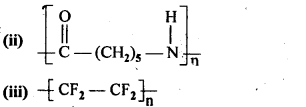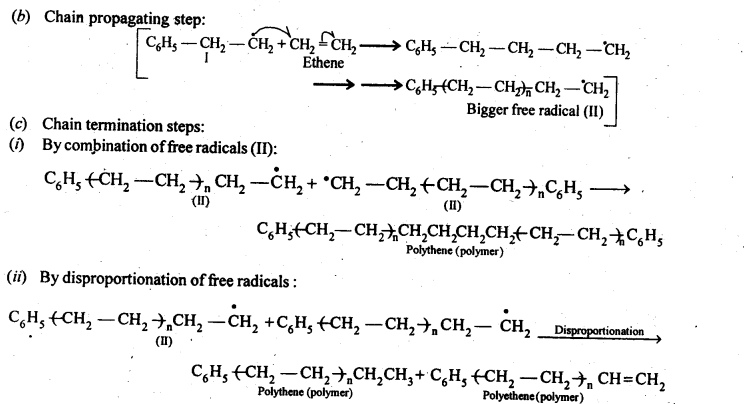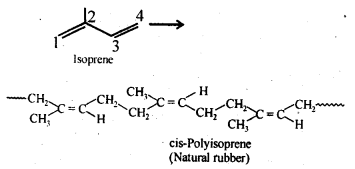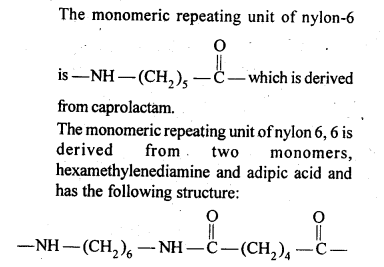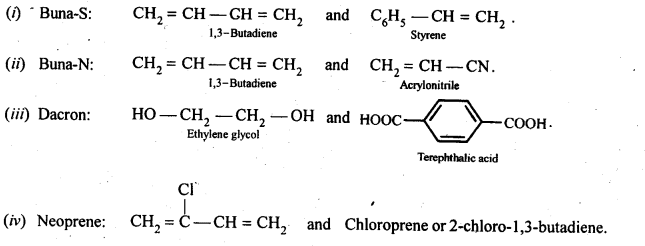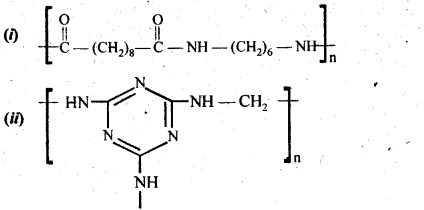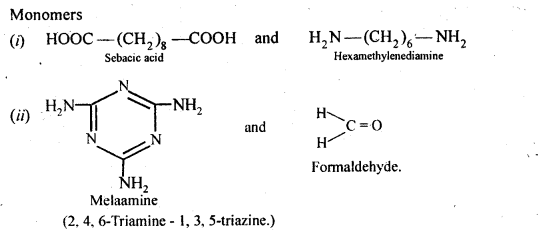Topics and Subtopics in NCERT Solutions for Class 12 Chemistry Chapter 15 Polymers:
| Section Name | Topic Name |
| 15 | Polymers |
| 15.1 | Classification of Polymers |
| 15.2 | Types of Polymerisation Reactions |
| 15.3 | Molecular Mass of Polymers |
| 15.4 | Biodegradable Polymers |
| 15.5 | Polymers of Commercial Importance |
NCERT INTEXT SOLUTIONS
15.1 What are polymers?
Ans. Polymers are high molecular mass substances (103 — 107u) consisting of a very large number of simple repeating structural units joined together through covalent bonds in a linear fashion. They are also called macromolecules. Ex: polythene, nylon 6,6, bakelite, rubber, etc.
15.2 How are polymers classified on the basis of structure?
Ans. On the basis of structure, polymers are classified as :
(i)Linear polymers in which the monomers are joined together to form long straight chains of polymer molecules. Forex: HDPE, PVC, nylons, etc.
(ii)Branched chain polymers in which the monomers not only join in linear fashion but also form branches of different lenghts along the main chain. For ex : LDPE, glycogen, etc.
(iii)Cross-linked polymers in which the intially formed linear polymer chains join together to form 3D network structure. For ex : bakelite, Urea-formaldehyde resin, etc.
15.3 Write the names of the monomers of the following polymers:
Ans. (i) Hexamethylene diamine NH2-(CH2)6NH2 and adipic acid HOOC – (CH2)4 – COOH
(ii)Caprolactum
(iii)Tetrafluoroethene F2C = CF2
15.4 Classify the following as addition and condensation polymers:
Terylene, Bakelite, Polyvinyl chloride,Polythene
Ans.Addition polymers: Polyvinyl chloride, Polythene
Condensation polymers : Terylene, bakelite.
15.5 Explain the difference between Buna- N and Buna-S.
Ans. Both are copolymers. Buna-N is a copolymer of 1,3-butadiene and acrylonitrile whereas Buna-S is a copolymer of 1,3-butadiene and styrene.
15.6 Arrange the following polymers in increasing order of their intermolecuiar forces.
(i)Nylon 6,6, Buna-S, Polythene
(ii)Nylon 6, Neoprene, Polyvinyl chloride
Ans. On the basis of intermolecuiar forces, polymers
are classified as elastomers, fibres and plastics. The increasing order of intermolecuiar forces is: Elastomer < Plastic < fibre.
Thus, we have
(i)Buns-S < Polythene < Nylon 6,6
(ii)Neoprene < Polyvinyl chloride < Nylon 6.
NCERT EXRECISES SOLUTIONS
15.1 Explain the terms polymer and monomer.
Ans. Polymers are high molecular mass substances consisting of a very large number of simple repeating structural units joined together through covalent bonds in a regular fashion. Polymers are also called macromolecules. Some examples are polythene, nylon-66, bakelite, rubber, etc. Monomers are the. simple and reactive molecules from which the polymers are prepared either by addition or condensation polymerisation. Some examples are ethene, vinyl chloride, acrylonitrile, phenol and formaldehyde etc.
15.2 What are natural and synthetic polymers? Give two examples of each type.
Ans.Natural polymers: Polymers which are found in nature,i.e., in animals and plants are called natural polymers, e.g., proteins, starch, cellulose, nucleic acids, resins and natural Sol. rubber.
Synthetic polymers: Man-made polymers are called synthetic polymers, e.g., plastics (polythene, PVC), synthetic fibres (polyester, 15.8 nylon-66) and synthetic rubber (neoprene, Buna-S).
15.3 Distinguish between the terms homopolymer and copolymer and give an example of each.
Ans.Polymers whose repeating structural units are derived from only one type of monomer units are called homopolymers, e.g., PVC polyethene, PAN, teflon, polystyrene, nylon- 6 etc.
Polymers whose repeating structural units are derived from two or more types of monomer molecules are copolymers, e.g., Buna-S, Buna-N, nylon-66, polyester, bakelite.
15.4 How do you explain the functionality of a monomer?
Ans.Functionality means the number of binding sites in a molecule. For example, the functionality of ethene, propene, styrene, acrylonitrile is one while that of 1,3-butadiene, adipic acid, terephthaliC’ acid, hexa methylenediamine is two.
15.5 Define the term polymerisation?
Ans.It is a process of formation of a high molecular Sol. mass polymer from one or more monomers by linking together a large number of repeating structural units through covalent bonds.
15.6 Is (-NH — CHR—CO-)n a homopolymer or copolymer?
Ans.It is a homopolymer because the repeating structural unit has only one type of monomer, i.e., NH2—CHR—COOH.
15.7 In which classes, the polymers are classified on the basis of molecular forces?
Ans.(a)Elastomers
(b)Fibres
(c)Thermoplastics
(d)Thermosetting plastics
15.8 How can you differentiate between addition and condensation polymerisatiop?
Ans.In addition polymerization, the molecules of the same or different monomers simply add on to one another leading to the formation of a macromolecules without elimination of small molecules like H2O, NH3 etc. Addition polymerization generally occurs among molecules containing double and triple bonds. For example, formation of polythene from ethene and neoprene from chloroprene, etc. In condensation polymerisation, two or more bifunctional trifimctional molecules undergo a series of independent condensation reactions usually with the elimination of simple molecules like water, alcohol, ammonia, carbon dioxide and hydrogen chloride to form a macromolecule. For example, nylon-6,6 is a condensation polymer of hexamethylenediamine and adipic acid formed by elimination of water molecules.
15.9 Explain the term copolymerisation and give two examples.
Ans.When two or more different monomers are allowed to polymerise together the product formed is called a copolymer, and the process in called copolymerisation. Example, Buna-S and Buna-N. Buna- S is a copolymer of 1, 3- butadiene and styrene while Buna-N is a copolymer of 1,3-butadiene and acrylonitrile.
15.10 Write the free radical mechanism for the polymerisation of ethene.
Ans.
15.11 Define thermoplastics and thermo setting polymers with two examples of each
Ans. Thermoplastics polymers are linear polymer which can be repeatedly melted and moulded again and again on heating without any change in chemical composition and mechanical strength. Examples are polythene and polypropylene.
Thermosetting polymers, on the other hand, are permanently setting polymers. Once on heating in a mould, they get hardened and set, and then cannot be softened again. This hardening on heating is due to cross- linking between different polymeric chains to give a three dimensional network solid. Examples are bakelite, melamine-foimaldehyde polymer etc.
15.12 Write the monomers used for gettingThe following polymers:
(i) Polyvinylchloride
(ii) Teflon (iii) Bakelite
Ans.
15.13 Write the name and structure of one of the common initiators used in free radical addition polymerisation.
Ans.
15.4 How does the presence of double bonds in rubber molecules influence their structure and reactivity?
Ans.Natural rubber is cis-polyisoprene and is obtained by 1, 4-polymerization of isoprene units. In this polymer, double bonds are located between C2 and C3 of each isoprene unit. These cis-double bonds do not allow the polymer chains to come closer for effective interactions and hence intermolecular forces are quite weak. As a result, natural rubber, i.e., cis-polyisoprene has a randomly coiled structure not the linear one and hence show elasticity.
15.5 Discuss the main purpose of vulcanisation of rubber.
Ans.Natural rubber has the following disadvantages:
(a) It is soft and sticky and becomes even more so at high temperatures and brittle at low temperatures. Therefore, rubber is generally used in a narrow temperature range (283-335 K) where its elasticity is maintained.
(b)It has large water absorption capacity, has low tensile strength and low resistance to abrasion.
(c)It is not resistant to the action of organic solvents.
(d)It is easily attacked by oxygen and other oxidising agents. .
To improve all these properties, natural rubber is vulcanised by heating it with about 5% sulphur at 373-415 K. The vulcanized rubber thus obtained has excellent elasticity over a larger range of temperature, has low water absorption tendency and is resistant to the action of organic solvents and oxidising agents.
15.16 What are the monomeric repeating units of Nylon-6 and Nylon 6,6?
Ans.
15.17 Write the names and structures of the monomers of the following polymers:
(i) Buna-S (ii) Buna-N (iii) Dacron (iv) Neoprene
Ans.
15.18 Identify the monomer in the following polymeric structures:
Ans.
15.19 How is dacron obtained from ethylene glycol and terephthalic acid?
Ans.Dacron is obtained by condensation polymerization of ethylene glycol and terephthalic acid with the elimination of water molecules. The reaction is carried out at 420 – 460 K in presence of a catalyst consisting of a mixture of zinc acetate and antimony trioxide.
15.20 What is a biodegradable polymer ? Give an example of a biodegradable aliphatic polyester.
Ans. Polymers which disintegrate by themselves over a period of time due to environment degradation by bacteria, etc., are called biodegradable polymers. Example is PHBV, i. e., Poly-β-Hydroxybutyrate-co-β- Hydroxyvalerate.

